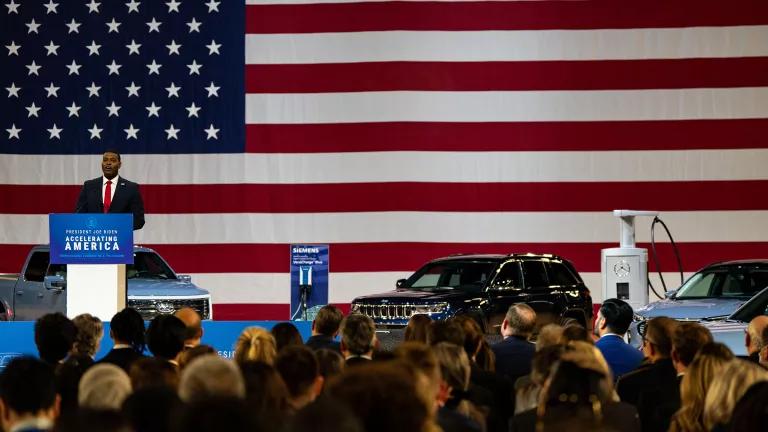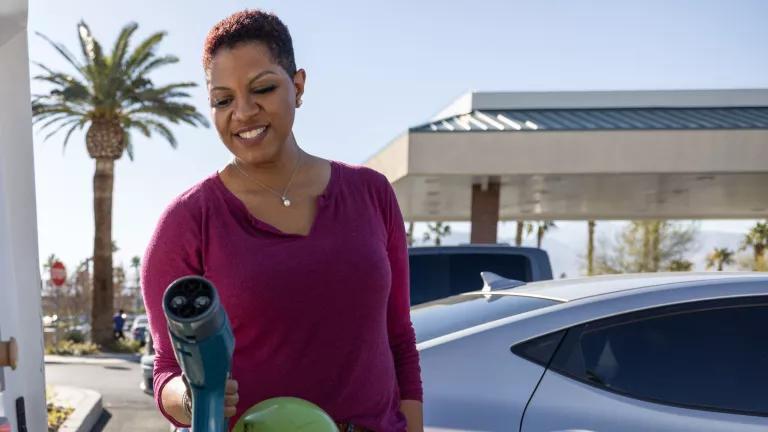New York State Enacts Electric Vehicle Consumer Rebate Program
Kudos go out today to New York’s Governor Andrew Cuomo and the state’s legislators for incorporating consumer rebates toward the purchase of new electric vehicles (EVs) into the state’s annual budget for the first time. These rebates, which will offer buyers as much as $2,000 for a battery-only electric vehicle, a plug-in hybrid, or a fuel-cell EV, will help New York drivers kick our addiction to polluting petroleum fuels. Importantly, they’ll help us meet New York’s ambitious and scientifically-mandated climate goals: cutting economy-wide greenhouse gas emissions by 40 percent by 2030 and 80 percent by 2050. Given that transportation-related emissions account for more than one-third of New York’s greenhouse gas pollution, these incentives can put us on the right path toward cleaner air, a more stable climate, and a much-needed transition to cleaner vehicles.
The benefits don’t stop there, either. By boosting EV use in the Empire State, these incentives can help keep our energy dollars here in New York, rather than sending them out of state and out of the country, where we now spend a full $20 billion to import gasoline and diesel fuel every year. In other words, these incentives won’t just benefit would-be EV drivers. By keeping our energy dollars local, they’ll help New York’s economy and New Yorkers overall.
Let’s get back to the climate benefits, though. Already, an EV charged on the New York electric grid is a win for the climate when compared to a conventional vehicle. In fact, NRDC’s research with the Electric Power Research Institute shows that a New York-charged electric car has the emissions equivalent of gasoline vehicle that gets over 120 miles per gallon. And that’s given the current electric mix. As New York progresses toward its 50-percent-by-2030 clean electricity target, a goal now being enacted by the New York State Public Service Commission, and gets more and more of its electricity from pollution-free sources such as wind and solar power, pollution from these vehicles will decrease further.
Cutting transportation-related carbon and other air pollution is a significant challenge and one that New York’s state government has already taken up as part of a coalition that includes California and Oregon on the West Coast, and Connecticut, Maryland, Massachusetts, Rhode Island, and Vermont here on the East Coast. Together, in 2013, they pledged to get 3.3 million zero emissions vehicles (ZEVs) on the road by 2025.
Now, for the first time, New York is really putting its money where its mouth is, offering as much as $2,000 to purchasers of new EVs, plug-in hybrids, and fuel-cell EVs. In doing so, it joins other Northeast and Mid-Atlantic pioneering states including Connecticut, Delaware, Massachusetts, and Rhode Island in promoting cleaner transportation options for drivers through EV rebates. (The federal government also offers an EV tax credit that’s worth as much as $7,500 per vehicle.)
These incentives aren’t giveaways to buyers. Rather, as we’ve seen with government incentives for wind and solar power, they’re tools to spur demand and thereby speed economies of scale. In turn, they drive both investments in new technologies and competition in the market place, which lowers prices for everyone. Progress is being made and the EV future is bright. Already, EV battery prices are dropping fast, and new vehicles with mainstream prices—both EVs and plug-in hybrids with extended ranges—are being delivered to dealers’ showrooms and sales are up. Despite really low gas prices, EV sales in the first two months of 2016 were up 9 percent over the same period last year.
There’s still much work to be done to move New Yorkers off of gasoline and diesel and on to EVs powered by increasingly cleaner energy. Just as incentives can boost sales, so, too, can the deployment of publicly available charging stations. In the past seven years, New York has gone from fewer than a dozen public stations to more than 1,200. By committing to increase that number, as California and its utilities recently have, New York can further smooth this essential transition away from polluting fuels.
Let’s savor this important milestone. By supporting consumer EV rebates, New York is solidifying its leadership in clean transportation and moving us an important step closer to a more stable climate and cleaner air for all.




